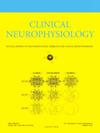Diagnostic utility of threshold tracking TMS paradigms in early amyotrophic lateral sclerosis
IF 3.7
3区 医学
Q1 CLINICAL NEUROLOGY
引用次数: 0
Abstract
Objective
Threshold tracking transcranial magnetic stimulation (TMS) has exhibited utility as a diagnostic technique in Amyotrophic Lateral Sclerosis (ALS). Different threshold tracking paradigms have recently been proposed. The present study assessed the diagnostic utility of serial ascending and parallel threshold tracking TMS in ALS.
Methods
Threshold tracking TMS was undertaken on 90 prospectively recruited participants suspected of ALS. Short interval intracortical inhibition (SICI) was recorded with serial ascending and parallel threshold tracking paradigms between Interstimulus Interval (ISI) 1-to-7 ms. The primary outcome measure was differences in diagnostic utility of the paradigms in differentiating ALS from ALS mimicking disorders using receiver operating characteristic (ROC) analysis (DeLong statistical method).
Results
Reduction in SICI reliably differentiated ALS from mimic disorders, irrespective of the threshold tracking paradigm. Comparison of area under the curve (AUC) established a significantly higher value for mean SICI (1–7 ms) with the serial ascending SICI paradigm (0.81, 95 % confidence interval 0.72–0.91) compared to the parallel paradigm (SICI 0.72, 95 % confidence interval 0.61–0.83, p = 0.0065). The better diagnostic utility of serial ascending paradigm was evident for SICI recorded between 1-to-5 ms, and was maintained irrespective of disease onset site, degree of functional impairment, and the degree of lower motor neuron dysfunction. A comparable diagnostic utility across threshold tracking paradigms was evident in ALS participants who presented with a relative paucity of upper motor neuron signs.
Conclusion
While threshold tracking TMS reliably differentiated ALS from mimic disorders, the present study established better diagnostic utility with the serial ascending threshold tracking TMS paradigm.
Significance
The serial ascending threshold tracking TMS should be used in a clinical setting as a diagnostic tool for ALS.
阈值追踪TMS模式在早期肌萎缩性侧索硬化症中的诊断价值
目的:阈值跟踪经颅磁刺激(TMS)作为一种诊断肌萎缩性侧索硬化症(ALS)的技术已被证实具有实用价值。最近提出了不同的阈值跟踪范式。本研究评估连续上升和平行阈值追踪TMS在ALS中的诊断效用。方法对90例疑似ALS患者进行TMS阈值追踪。在刺激间隔(ISI) 1 ~ 7 ms之间,用连续上升和平行阈值跟踪范式记录短间隔皮质内抑制(SICI)。主要结果测量是使用受试者工作特征(ROC)分析(DeLong统计方法)区分ALS和ALS模仿障碍的范式诊断效用的差异。结果SICI的减少可靠地将ALS与模拟疾病区分开来,而不考虑阈值跟踪范式。曲线下面积(AUC)的比较表明,连续上升SICI模式的平均SICI (1-7 ms)值(0.81,95%置信区间0.72 - 0.91)显著高于平行模式(0.72,95%置信区间0.61-0.83,p = 0.0065)。序列上升模式对1- 5 ms间记录的SICI具有更好的诊断效用,并且与疾病发病部位、功能损伤程度和下运动神经元功能障碍程度无关。在表现出相对缺乏上运动神经元体征的ALS参与者中,跨阈值跟踪范式的可比诊断效用是明显的。结论阈值追踪TMS能可靠地区分ALS和模拟障碍,本研究建立了连续上升阈值追踪TMS模式更好的诊断效用。意义:连续上升阈值追踪TMS应作为ALS的临床诊断工具。
本文章由计算机程序翻译,如有差异,请以英文原文为准。
求助全文
约1分钟内获得全文
求助全文
来源期刊

Clinical Neurophysiology
医学-临床神经学
CiteScore
8.70
自引率
6.40%
发文量
932
审稿时长
59 days
期刊介绍:
As of January 1999, The journal Electroencephalography and Clinical Neurophysiology, and its two sections Electromyography and Motor Control and Evoked Potentials have amalgamated to become this journal - Clinical Neurophysiology.
Clinical Neurophysiology is the official journal of the International Federation of Clinical Neurophysiology, the Brazilian Society of Clinical Neurophysiology, the Czech Society of Clinical Neurophysiology, the Italian Clinical Neurophysiology Society and the International Society of Intraoperative Neurophysiology.The journal is dedicated to fostering research and disseminating information on all aspects of both normal and abnormal functioning of the nervous system. The key aim of the publication is to disseminate scholarly reports on the pathophysiology underlying diseases of the central and peripheral nervous system of human patients. Clinical trials that use neurophysiological measures to document change are encouraged, as are manuscripts reporting data on integrated neuroimaging of central nervous function including, but not limited to, functional MRI, MEG, EEG, PET and other neuroimaging modalities.
 求助内容:
求助内容: 应助结果提醒方式:
应助结果提醒方式:


